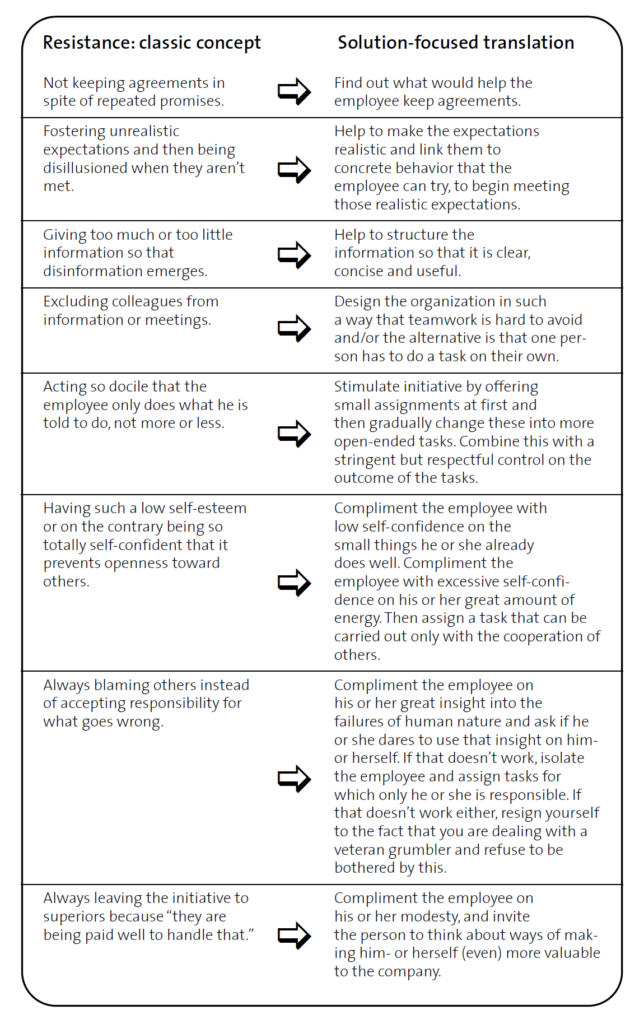Episode 6 – The Man in the Middle: A Solution Focused Feuilleton
Steve: “OK, that’s clear. I can understand. I know that you have been doing the most difficult jobs within the department for years now. In the past few months, you have worked very hard to introduce the new employees to their jobs as smoothly and quickly as possible. Everyone admits that the past few months haven’t been easy, especially not for you, Peter. Now, you know as well as I do that there are things that you, and I, can’t change. All those changes within Solteam belong to the world of limitations. We can only accept them and learn to deal with them in the best possible way. I have noticed that you handled all the changes in as positive a way as possible. How did you manage to cope with that?”
After complimenting him, Steve subtly teaches Peter about the difference between problems and limitations He then uses a kind of “coping” question. By asking Peter how he handled his problems in the past, Steve implies that Peter has been successful in handling them. In itself, this question hides a compliment. This solution- building question gives Peter the opportunity to think, despite all the difficulties, about his strengths and resources.

Peter: “What a strange question. I was just doing my job, what else? I have never been the type that gives up. I have always kept my promises towards my employers. When I take on a job, I go for it. Up until now, I have never met a challenge that I couldn’t handle. Mind you, I am no superman. I’ve had my share of difficulties but somehow I always coped.”
Steve is trying to “join” with Peter in order to establish a cooperative relationship with him. Peter reacts favorably to Steve’s authentic and respectful approach.
Steve: “Excellent. That’s the go-getter I know. So, I’ll repeat my question: What do we have to discuss today so that our meeting will be useful to you?”
Peter: “If we were able to work together constructively like it used to be, everybody would make efforts to contribute to the greater cause of the company instead of just minding their own career. I would like to get the mandate to manage the dismantling of the old production line in my own manner. I am not a child who needs supervision. I want management to let me do my job without having to inform them about every little turn I take. I never had to do that in the past and things went fine then. But I don’t think they’ll go for that. John doesn’t trust me, and the management doesn’t support me. Since the merger everything has changed because a lot of new employees came along. I do want to give them proper training but I’m afraid they’re only interested in advancing their own careers. So, I could use your advice about what I need to do to get my team cooperating again.”
The relationship between Steve and Peter now develops into a searching relationship: Peter asks for help. He is asking for a mandate to handle the project in his way and, at the same time, he wants to rebuild the cooperative mood in the team. Although these answers are perfectly legitimate, they do not express his goals in a workable format. As we will soon see, Steve can help Peter transform his goals by asking the right questions. As their working relationship is just moving into the searching mode, Steve decides to take a little step back.
Steve: “Excellent, Peter. That’s a good start. Here we are, at your office on a Friday morning, we have only been talking for about half an hour about how we can solve your case, and you have already come up with very valuable ideas.”
Steve now uses the technique of yes-setting to increase the likelihood that Peter will continue to approach the situation positively. Steve chooses to follow the solution-focused adage: “If in a hurry, go slow!” He decides to use a scaling question.
Steve: “Peter, before we go deeper into this, can I ask you a question? If we take a scale from zero to ten, where zero stands for the moment last week when you felt that it would be better to resign and ten stands for your belief that things might not be perfect but they are good enough for you to continue working, where are you now?”
Peter: “At a two.”
Steve: “Good. What does the two mean? What has changed in the past week to get you from a zero to a two?”
Peter: “The fact that you are talking to me about how we can solve this. Even though I still don’t see what good could come out of this mess. Well, maybe also the fact that John mailed me that the management wants me to do the dismantling. Oh, and the fact that John sent me a memo to wish me ‘the best’ of luck — and especially that I haven’t heard from him or seen him since.”
Remembering James William’s famous quote: “The art of being wise is the art of knowing what to overlook,” Steve does not react to Peter’s slightly cynical remark. He accepts all Peter’s answers even though some weren’t useful. He keeps the questioning going.
Steve: “Perfect. What would be the next small step forward?”
Peter: “I don’t know. But I do know that you ask me a lot of questions.”
Steve: “Yes, I do, and do you know why? Because the right questions bring out the solutions!”
Peter: “That’s funny. I never thought of it like that, but I must admit you have a point. There is one more thing needed, however.”
Steve: “And that is?”
Peter: “You need to be able to listen to the answers.”
With a seemingly casual remark, Steve teaches Peter the art of solution- building questions. Peter reacts favorably by going along with it. This strengthens the working relationship and introduces the solution-focused approach without their even having to talk about it.
Steve: “You are getting there, Peter, congratulations. So, you’re saying that the fact that John has at least left you alone, that the management has entrusted the dismantling to you, and that the two of us are now working on a constructive solution is worth a two. Excellent!
(to be continued)
Read episode 7
Back to episode overview
‘The Man in the middle’ is an excerpt from the book ‘The Solution Tango’ (and ‘Solution Focused Coaching’ e-book) by Louis Cauffman. This book presents a new approach to conquering the numerous challenges, problems, and failures that managers encounter at work, many of which are people-related. An important lesson identified in the book is that a manager must act as both the leader who provides direction for a team or company and as the coach who enables others to make the most of their skills, enabling the individual and the organization to succeed. A seven-step framework to enhance problem-solving capabilities, examples and tips, and a survival kit for sinking managers will help managers improve their people skills and learn how to approach everyday issues from a positive perspective.
 LOUISCAUFFMAN.COM
LOUISCAUFFMAN.COM











